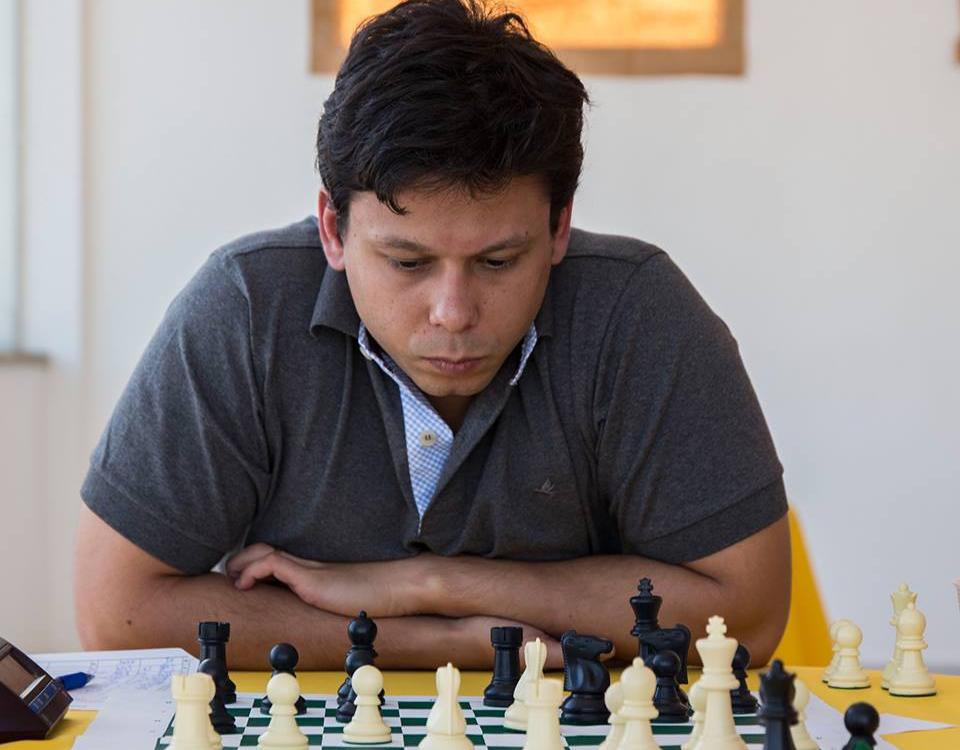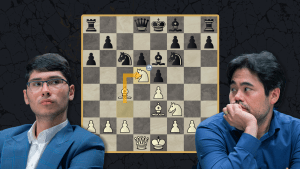
Modern day analysis: working with the computer
In this article, I will expand on some ideas that were presented when I wrote about preparing your opening repertoire. Many chess players have no clue on how to use the machine to their benefit. I hope that after reading my advice, you will have a much better idea of what you must do and will avoid the common mistakes made by those who thoughtlessly use chess engines. Since I am a GM both on correspondence (where nowadays everyone analyzes with the engines) and over the board chess, I know both sides of the coin: the scientific and the practical.
An incorrect work in this field can be very harmful to the tournament player, leading him to stop thinking for himself and only believe the computer's suggestions. I know many players who work like that. They have no patience to think about the position anymore. The result of this is a total lack of creativity in his analysis and a worsening of his practical skills of calculation and decision-taking. When I ask them why they do it, usually the answer is that they save time since the screen suggestion will be better than what they think, anyway.
But this idea of “saving time” is not the correct approach for those who seek to achieve grandmaster class. Independent analysis, even though it's more time-consuming, is what makes the difference. When asked about what directions chess would take with the growth of technology, the great Mikhail Botvinnik said computers would be a good tool, but independent analysis would always be necessary.
Unfortunately, many chess students do not see it this way. They spend many hours looking at the screen, memorizing openings, or passively reproducing books and engines' suggestions. This method is completely wrong. To improve, you have to understand and question these analyses, and have your own ideas. With this aim, chess softwares can be very useful if used correctly.
Obviously, like with everything in life, people diverge on how to use this tool. I will propose two methods of working with the computer, which I think will be very useful for your training:
Method 1 (the same I proposed in my previous article):
I-Setup the position on the board and on your computer;
II- Turn on the analysis engine, minimize the ChessBase screen (so you can't see what it suggests), and analyze the position for some time (15 minutes is a good start). You can work moving the pieces;
III- After this initial time, verify your computer´s suggestions and compare them with your own conclusions. Minimize the screen again and repeat the individual work, analyzing the machines’ ideas;
IV- Repeat the process until you reach trustworthy conclusions.
There is another interesting method that virtually transforms the computer into a coach. This one is especially useful when watching games fast in your database:
Method 2:
I- Open your preferred chess engine;
II- Resize it on your screen in a way you see only the engine's evaluation and depth, but not the moves;
III- Whenever the evaluation goes way high or down, try to find out why that happens and what is the best move in the position.
Let's now take a look at one of my wins in the 26th World Correspondence Championship. In spite of my inexperience in this format, I was able to finish in third place and become a GM. This happened, I think, because I used good judgment to go along with the computer analysis.
Leitao,Rafael (2572) - Schuster,Peter (2451) [D85]
W-ch26 email ICCF email, 10.06.2010
1.Nf3 Nf6 2.c4 c5 3.Nc3 d5 4.cxd5 Nxd5 5.d4 Nxc3 6.bxc3 g6 7.e4 Bg7 8.Be3 Qa5 9.Qd2 0–0 10.Rc1 Bg4 11.d5 Na6
11...Bxf3 is played more often
12.h4 h5?
A conceptual mistake. This is one of those positions the computer do not understand. Players familiar with white's typical attacking ideas in these structures know that withe's pawn will break black's position with g4 (like in the Dragon Defense), sacrificing pawns and pieces to get the attack going. The engines do not suggest this plan immediately. Here we can appreciate the best of human – machine analysis: our brains showing the correct path, based on concepts acquired by the study of typical positions, while the machine gives us the mathematical verification of the idea. In attacking positions you should not give up your opinions or be easily influenced by the computer, as the machine makes many evaluation mistakes, changing his assessment abruptly when we make the moves on the board. Since most of the chess players trust these evaluations without second thoughts, sometimes it is possible to find flaws in his preparation or win correspondence games easily.
12...f5 was played in Kramnik - Svidler, 2009, but black didn't solve his opening problems.
13.Ng5!
The natural move to explore h7-h5. The plan is f3-g4.
13...Rad8 14.f3 Bd7
Another extravagant computer move. It is more logical to retreat the bishop to c8, not restrict the d8 rook.
15.g4 hxg4
15...f6 16.Nh3±
16.h5
White's attack is decisive and the position is mathematically winning.
16...gxh5
16...gxf3 17.hxg6 fxg6 18.Bc4 (18.d6) ; 16...f6 17.h6+– (17.d6)
17.Qh2
17.Rxh5 would also be sufficient, but the text move is more energetic.
17...f6 18.Qxh5!
18.Ne6 Bxe6 19.dxe6 c4 would be the lesser evil.
18...fxg5 19.Qh7+ Kf7 20.d6! Qxa2
20...e6 21.Bc4 Rh8 (21...Qa4 22.0–0) 22.Qf5+ Bf6 23.Bxg5+–; 20...Be6 21.Qh5+ Kg8 22.dxe7+–; 20...b5 21.fxg4+–
21.dxe7 gxf3 22.Rh2 Qe6
22...Qb3 23.Bxg5+–
23.Bxg5 Rde8 24.Qh5+ Kg8 25.exf8Q+ Kxf8
25...Rxf8 26.Qh7+ Kf7 27.Rf2+–
26.Qxf3+
26.Rh4 Qf7 27.Qxf7+ Kxf7 28.Kf2 Nc7 29.Rd1 Be6 30.Bd8 Na8 31.Bb5 Rf8 32.Rd3+–
26...Kg8
26...Qf7 27.Qxf7+ Kxf7 28.Kd2
27.Bd3 Rf8 28.Qh5 Rf7 29.Qh7+ Kf8 30.Bh6 Qg4 31.Bxg7+ Qxg7 32.Qxg7+ Rxg7
Now we only need a bit of technique.
However, one more recommendation: in endgame positions, beware of computers' evaluation. Sometimes they do not notice theoretically drawn positions.
33.Bxa6! bxa6 34.Kd2 a5 35.Rh5 Rg4 36.Rxc5 Rxe4 37.Rxa5 a6 38.Rxa6 1–0
In the Brazilian Championship 2013 Finals I had the chance to again exploit my opponent's mistake in handling the computer, only this time it was an over the board fight.
Leitão,R (2636) - Molina,R (2424) [D31] João Pessoa (2), 14.12.2013
1.d4 d5 2.c4 e6 3.Nc3 Be7 4.cxd5 exd5 5.Bf4 c6 6.e3 Bf5 7.Nge2 Nd7 8.Ng3 Bg6 9.Be2 Nf8?!
This move, though it is one of the computer's main suggestions, is a mistake. Black ignores one of the most important opening rules, moving his knight once again and – even worse – hindering the development of his pieces. Of course the ideal is to place the knight in the active e6 square, but this is too slow. Now white is able to develop a strong initiative. My opponent was misguided by his computer. He analyzed the position with the engines running, accepting his suggestions without making a careful “human” analysis of the position. Indeed, if we delve deeply into the position it is not so difficult to conclude that white's next move is very promising.
10.h4!
Sacrificing material to develop the initiative. This is a classic way of exploiting a lead in development.
10...Bxh4
Nearly forced. 10...h6 would make no sense with black's previous play.
11.Qb3 Bxg3 12.Bxg3
Frankly, I didn't analyze many variations to conclude that this position was very good for white. It is clear that the compensation for the pawn is excellent: more development, bishop´s pair and dark squares weaknesses in black's positions – all this makes my opponent’s situation very dangerous. But, to my total surprise, Molina still was in his preparation and replied quite quickly:
12...Qe7?
13.e4!!
Another thematic sacrifice that effectively decides the game. Black's position falls apart now. Finally my opponent was out of his preparation, but now it is too late. At first the computer does not see anything special for white here. Leave it for some time and he will indicate a big advantage for white. This is the danger of analyzing too fast and trusting the machine blindly! The rest of the game is a nightmare for black.
13...dxe4?
13...Bxe4 14.Nxe4 dxe4 15.d5 Nf6
15...cxd5? 16.Bb5+ Nd7
17.Rh5!!+-
16.dxc6 bxc6 17.0-0-0 with a strong initiative.
14.d5+- Nf6 15.0-0-0?!
15.Rd1! Rd8 16.0-0!+-
15...Rd8?!
15...a5! 16.Qc4 (16.a3+/-) 16...Qb4 17.dxc6 Qxc4 18.cxb7!! Qc8 19.bxc8Q+ Rxc8 20.Bd6+-
16.dxc6 bxc6 17.Qa4?
17.Rxd8+ Qxd8 18.Qb7!+-
17...Qb7?
17...Qc5 18.Rxd8+ Kxd8 19.Rd1++-; 17...Bf5! 18.Qxc6+ Bd7 19.Qb7+/-]
18.Rxd8+ Kxd8 19.Rd1+ N8d7 20.Rd6+-
20.Ba6 Qb6 21.Rd6 Qc5 22.Rxc6 Qg5+ 23.Kd1+-
20...e3 21.Ba6! exf2 22.Bxf2 1-0
I hope the article was useful and that you understand how you should use the computer to improve your play.
I will be hosting a free webinar in English next Saturday, February 15, 2014 at 2 pm (GMT), on the theme: “How GM's Analyze”. If you are interested in taking part, contact me by message or by email: [email protected] or just subscribe and follow the instructions in the following link: https://attendee.gotowebinar.com/register/9040850164473767681






